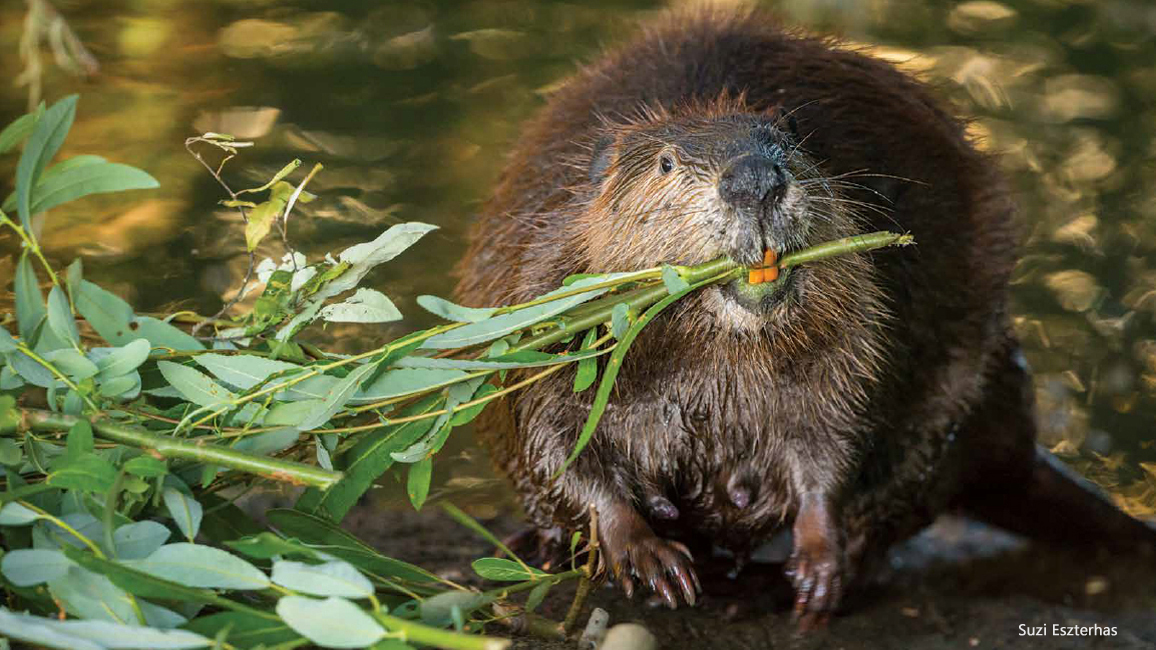
Leave It to Beavers
By Hannah Schardt; Photos by Suzi EszterhasOnce, many towns tried to keep beavers out of local rivers and streams. But now, some are leaving them alone—or even welcoming them in!
You may think the North American beaver is adorable. Just look at that friendly, funny face. (OK, so you won’t see it in any toothpaste ads.) Then there’s the beaver’s busy-busy behavior, nibbling and gnawing and building. But, believe it or not, many people think beavers, especially the ones that live in cities or towns, are pests.
That’s because beavers can make big changes to the places they live. For one thing, they cut down trees. They eat the leaves and tender twigs. And they use the trunks and branches to build dams that block the flow of water in rivers and streams. Those dams form ponds where beaver families can live safely in their lodges—partly underwater dens built of rocks, sticks, and mud.
Unfortunately, a beaver dam may cause the water to rise so high that it floods nearby streets. So for many years, people tried to keep beavers out of their towns and away from their homes.
But now, some people are working to make sure beavers can live happily in their communities. Turn the page to learn more about North America’s largest rodent— including why it makes a great neighbor!
Swimmers and Builders
With its big, flat tail and webbed back feet, a beaver is a born swimmer. Its nostrils and ear holes close up when it dives beneath the water’s surface. And special see-through eyelids allow it to see while it works on underwater construction projects.
A beaver’s teeth are like a built-in saw for cutting down trees for food and shelter. Those big, orange choppers are sharp, strong, and constantly growing.
Beaver History
As many as 100 million beavers once lived in North America. But when settlers arrived from Europe, they trapped too many of them for their soft, warm fur. Soon, beavers disappeared altogether from many places they’d once lived. More recently, people started protecting beavers and their habitat. Now, scientists believe at least 10 million beavers live in the United States and Canada.
In the last 100 years, as North America’s beaver population grew, so did the human population. As beavers moved back into streams and rivers, they often found people living nearby. But those people weren’t always happy to have beavers sharing space in their neighborhoods.
Good Neighbors
Eventually, scientists started to realize that beavers and their dams actually keep waterways healthy. Dams help prevent the soil around creeks from eroding, or crumbling. The pools created by dams make great homes for fish, birds, and other wildlife. And the dams help filter pollution out of the water.
So some people decided to figure out ways to live side by side with beavers. They discovered they could protect certain trees by wrapping them with wire or painting them with a rough, sandy mixture. (Beavers don’t like the feeling of sand on their teeth, so they move on to other trees.) And they invented a device sometimes called a “Beaver Deceiver.” When the water level in a beaver pond gets too high, this special pipe lets some water flow back out into the creek. That way, the beavers get a lodge that is safely surrounded by water— and the nearby streets and buildings stay nice and dry.
Welcome, Beavers!
A few towns have installed Beaver Deceivers or similar systems. But the people of Martinez, California, go even further to welcome beavers to their town. They plant beavers’ favorite food trees along the banks of the local creek! For 10 years, a beaver family has made its home in the creek.
“We found that when we helped the beavers, they helped us,” says Heidi Perryman, who started the Martinez group. “They attracted new kinds of wildlife and turned our little creek into a nature preserve.”
Each year, Perryman’s group throws a party for their busy friends: the Beaver Festival! People there—especially local kids—make beaver art, learn about beavers, and may even spot the local beaver family in the nearby creek.
Healing Hands
Sometimes, people who live near beavers find one that is sick, injured, or orphaned. Luckily, there are groups that will take care of it until it’s healthy or old enough to return to the wild.
While the beaver recovers, the people around it are careful not to let it become too comfortable around humans. They fee it the same food it would eat in the wild. And they make sure it gets lots of time to gnaw wood and practice its building skills.
Once the beaver is ready for life in the wild, its caretakers release it into a stream near where it was found.
Bye-bye, beaver. Hope to see you again soon!
“Leave It to Beavers” appears in the May 2018 issue of Ranger Rick magazine.
(Click on each image above for a closer view of the story.)



















